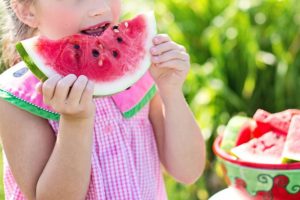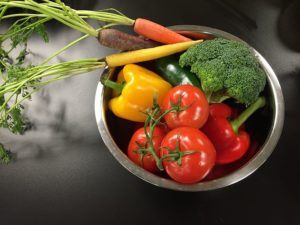 New school supplies, sneakers, backpack, and a lunch box–all the essentials for the start of a new school year! Schedules are hectic, but that does not mean healthy meals and snacks have to be a second thought. According to a study on dietary behaviors in school children, 45% percent of U.S. school children bring lunch to school on any given day and 45% bring snacks. However, little is known about the quality of the food our children are eating. Finding food that keeps your kids healthy and energized throughout the day is important, and we’re here to provide some tips for your back to school fuel!
New school supplies, sneakers, backpack, and a lunch box–all the essentials for the start of a new school year! Schedules are hectic, but that does not mean healthy meals and snacks have to be a second thought. According to a study on dietary behaviors in school children, 45% percent of U.S. school children bring lunch to school on any given day and 45% bring snacks. However, little is known about the quality of the food our children are eating. Finding food that keeps your kids healthy and energized throughout the day is important, and we’re here to provide some tips for your back to school fuel!
So, what’s the best way to fuel up as the fall ramps up? A go-to guideline for every meal or snack is to consume a carbohydrate, protein, and fat. These nutrients are called macronutrients. Carbohydrates are our body’s main energy source, proteins help rebuild and repair our body, and fat keeps us feeling satisfied until our next meal. Foods are generally classified as the one macronutrient they contain the most of, but many contain a mixture. Now, where do we get these macronutrients?
 Carbohydrates: Fresh, canned, or frozen fruit and vegetables in a variety of colors are great sources of carbohydrates. Whenever possible, go for the whole fruit instead of fruit juice. If your child drinks juice, then make sure it is 100% juice and limit the number of servings. Choose whole grains such as whole-wheat bread, oatmeal, quinoa, brown rice, or popcorn. Limit refined grains such as white bread, pasta, and rice as they have a higher glycemic load and not as much nutrition.
Carbohydrates: Fresh, canned, or frozen fruit and vegetables in a variety of colors are great sources of carbohydrates. Whenever possible, go for the whole fruit instead of fruit juice. If your child drinks juice, then make sure it is 100% juice and limit the number of servings. Choose whole grains such as whole-wheat bread, oatmeal, quinoa, brown rice, or popcorn. Limit refined grains such as white bread, pasta, and rice as they have a higher glycemic load and not as much nutrition.
 Protein: Vegetarian sources of protein include: beans, lentils, nuts, peas, seeds, and soy sources. Animal protein sources include: dairy, eggs, fish, shellfish, poultry, and various meats. Eat red meat and processed meats sparingly. Meat eaters may benefit from eating several vegetarian meals per week. Most Americans get plenty of protein.
Protein: Vegetarian sources of protein include: beans, lentils, nuts, peas, seeds, and soy sources. Animal protein sources include: dairy, eggs, fish, shellfish, poultry, and various meats. Eat red meat and processed meats sparingly. Meat eaters may benefit from eating several vegetarian meals per week. Most Americans get plenty of protein.
Fat: Healthy unsaturated fats from fish, nuts, seeds, avocado, and healthy oils from plants are some of the best sources. Limit trans fats and saturated fats.
 Variety is the key to keeping meals and snacks interesting, and also helps provide all of the macronutrients (carbohydrate, protein, fat) and micronutrients (vitamins and minerals) we need for a healthy, balanced diet. Nutrition experts from Harvard School of Public Health developed The Kid’s Healthy Eating Plate, which encourages us to fill half of our plate with colorful vegetables and fruits, and the other half with whole grains and healthy protein. These kid-friendly graphics offer examples for encouraging children to eat healthy and to keep moving! For more specific nutrition recommendations for girls and boys at various ages, check out these Guidelines.
Variety is the key to keeping meals and snacks interesting, and also helps provide all of the macronutrients (carbohydrate, protein, fat) and micronutrients (vitamins and minerals) we need for a healthy, balanced diet. Nutrition experts from Harvard School of Public Health developed The Kid’s Healthy Eating Plate, which encourages us to fill half of our plate with colorful vegetables and fruits, and the other half with whole grains and healthy protein. These kid-friendly graphics offer examples for encouraging children to eat healthy and to keep moving! For more specific nutrition recommendations for girls and boys at various ages, check out these Guidelines.
 Above all, keep eating fun! If your child is picky, then consider using lunch boxes with small divided containers to help keep foods separate while also promoting variety. Cutting or peeling food into different shapes is another great way to promote healthy eating while keeping it fun. Whenever you can, have your kids participate in food prep and encourage them to pack their lunches (and snacks) with you the night before.
Above all, keep eating fun! If your child is picky, then consider using lunch boxes with small divided containers to help keep foods separate while also promoting variety. Cutting or peeling food into different shapes is another great way to promote healthy eating while keeping it fun. Whenever you can, have your kids participate in food prep and encourage them to pack their lunches (and snacks) with you the night before.
Some of my favorite snack choices for you to try with your family include:
* Yogurt, Berries, Sliced Almonds
* Hummus, Pita Chips, Carrots
* Pretzels, Apples, Peanut Butter
For more inspiration for healthy recipes for kids, check out the Food Fun & Family Recipe Packet, EatRight.org, the Mayo Clinic’s snack tips, or talk to your Registered Dietitian Nutritionist!
Also, don’t forget to check out some of our past blog posts including: Better Breakfast Month, Score an A+ with Breakfast, Packing a Healthier Lunch, Simplify School Lunch, and Snacking Can Be Healthy.
Be Well,
Kylie McKenzie
Drexel University
Graduate Student in Nutrition